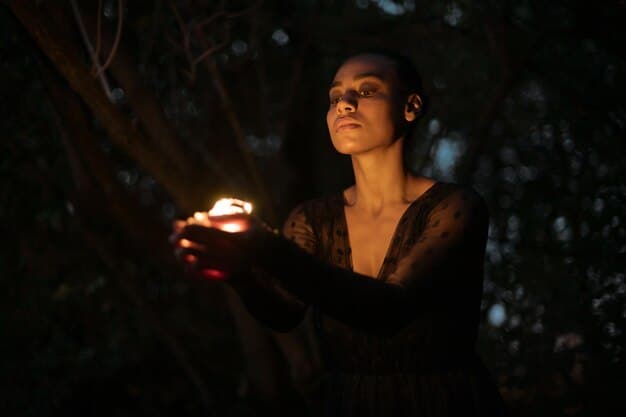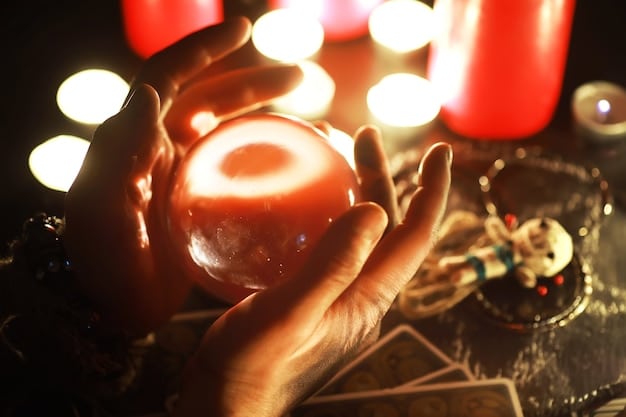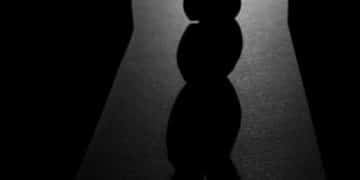Exploring Witchcraft Paths: Your Guide to Finding the Right Tradition

Exploring different paths in witchcraft involves understanding various traditions, such as Wicca, traditional witchcraft, eclectic witchcraft, and more, each offering unique practices and beliefs to align with individual spiritual journeys.
Embarking on a spiritual journey often leads individuals to explore various paths, and for those drawn to the mystical arts, exploring different paths in witchcraft can be a deeply fulfilling experience. With numerous traditions and practices available, finding the right fit can seem daunting, but understanding the nuances of each path can illuminate the way forward.
Understanding the Call to Witchcraft
The call to witchcraft is a deeply personal experience, often felt as an inexplicable pull toward the mystical and the unknown. It’s a recognition of an innate connection to nature, energy, and the spiritual realm. Understanding this call is the first step in exploring different paths in witchcraft.
This calling can manifest in various ways, such as a fascination with ancient lore, a resonance with certain symbols or deities, or a profound sense of being different. It is not merely a hobby or an interest but a spiritual hunger that seeks to be satiated.
Recognizing the Signs
How does one know if they are being called to witchcraft? There are several common signs to look for:
- Recurring Dreams: Vivid dreams featuring magical symbols, rituals, or interactions with deities can be significant.
- Increased Intuition: A heightened sense of intuition and psychic abilities may emerge.
- Pull Towards Nature: A deeper connection with nature, animals, and the changing seasons.
- Interest in the Occult: An insatiable curiosity about occult subjects, such as tarot, astrology, and herbalism.
It’s important to approach this call with an open mind and a willingness to learn. Recognizing the signs is just the beginning; the real journey lies in exploring the traditions that resonate most deeply with your soul.
In essence, the call to witchcraft is a personal invitation to discover and embrace one’s innate magical abilities. It signifies the commencement of a journey towards self-discovery, empowerment, and spiritual growth.
Overview of Major Witchcraft Traditions
Once you’ve recognized the call, the next step is to familiarize yourself with the major witchcraft traditions. Each tradition offers a unique framework of beliefs, practices, and philosophies, providing a diverse range of options for exploring different paths in witchcraft.
Understanding these traditions is crucial in finding a path that aligns with your values, interests, and spiritual goals. Let’s delve into some of the most prominent and influential traditions.
Wicca
Wicca is one of the most well-known and widely practiced traditions of modern witchcraft. It emphasizes reverence for nature, the balance of masculine and feminine energies, and the celebration of seasonal cycles through Sabbats and Esbats.
Wicca often involves deity worship, typically of a God and Goddess, and ethical guidelines such as the Wiccan Rede: “An it harm none, do what ye will.” Wiccan practices include spellcasting, ritual work, and energy manipulation.
Traditional Witchcraft
Traditional witchcraft, also known as cunning craft, diverges from Wicca by focusing on historical practices and folk magic. It often involves working with spirits, familiar entities, and ancient deities. Traditional witchcraft emphasizes personal gnosis and direct experience over structured dogma.
- Folk Magic: Rooted in local customs and practices focusing on healing, protection, and divination
- Spirit Work: Contacting and working with spirits, ancestors, and other entities
- Practical Application: Emphasis on tangible results and real-world effectiveness
Traditional witchcraft is often shrouded in secrecy, and practitioners may belong to covens or operate independently.
In summary, understanding the distinct characteristics of these traditions is essential in navigating the varied landscape of witchcraft. Each path offers something unique, and it’s up to the individual seeker to find the one that resonates most deeply.

Eclectic Witchcraft and Solitary Practice
For those who find themselves drawn to elements of various traditions, eclectic witchcraft offers a flexible and personalized approach. Solitary practice, whether eclectic or aligned with a specific tradition, provides a path for independent exploration and self-discovery within the craft. Such choices become integral when exploring different paths in witchcraft.
Eclectic witchcraft allows practitioners to create their own unique blend of beliefs and practices, drawing from diverse sources like Wicca, paganism, folk magic, and indigenous traditions. It’s a path of self-directed learning and experimentation.
Benefits of Eclectic Practice
There are several advantages to choosing an eclectic path:
- Personalization: Tailor your practice to fit your individual needs and preferences.
- Flexibility: Adapt your beliefs and practices as you grow and evolve.
- Freedom: Escape the constraints of rigid dogma and established traditions.
However, it’s essential to approach eclectic witchcraft with a solid foundation of knowledge and a commitment to ethical responsibility.
Solitary practice, on the other hand, refers to practicing witchcraft without the involvement of a coven or group. Solitary witches can follow any tradition or create their own unique path. This approach allows for introspection, self-reliance, and a deeper connection to one’s inner wisdom.
Ultimately, choosing between eclectic witchcraft and solitary practice depends on your individual preferences and learning style. Both paths offer unique opportunities for growth and empowerment within the craft.
Connecting with Deities and Spirits
Many witchcraft traditions involve working with deities and spirits, whether through worship, invocation, or collaboration. Understanding how to connect with these entities is a crucial aspect of exploring different paths in witchcraft. This connection can profoundly influence one’s practice and deepen their spiritual understanding.
Deities represent higher powers and archetypal energies that can guide and inspire practitioners. Spirits, on the other hand, are often seen as intermediaries or helpers who can assist with specific tasks or provide knowledge.
Approaches to Deity Work
Here are some common approaches to working with deities:
- Devotion: Honoring a specific deity through prayer, offerings, and rituals.
- Invocation: Calling upon a deity to lend their energy and presence to a ritual or spell.
- Collaboration: Working with a deity as a partner in achieving specific goals.
It’s important to research and understand the deities you choose to work with, respecting their history, mythology, and associated correspondences.
Connecting with spirits requires a different approach. Start by creating a safe and respectful environment, and clearly state your intentions. Use divination tools like tarot cards or pendulums to communicate with spirits, and always exercise discernment and caution.
Connecting with deities and spirits can be a profound and transformative experience. It can open doors to new levels of insight, empowerment, and spiritual connection. However, it’s essential to approach this aspect of witchcraft with reverence, responsibility, and ethical consideration.

Tools and Techniques in Witchcraft
The practice of witchcraft often involves the use of various tools and techniques to channel energy, manifest intentions, and connect with the spiritual realm. Understanding these tools and techniques is essential when exploring different paths in witchcraft, enhancing the effectiveness and depth of your practice.
From simple herbs and crystals to complex rituals and spells, the tools and techniques used in witchcraft can vary widely depending on the tradition and personal preference.
Essential Witchcraft Tools
Some commonly used tools include:
- Candles: Used to represent elements, deities, or intentions.
- Herbs: Employed for their magical properties in spells, potions, and incense.
- Crystals: Utilized to amplify energy and enhance specific intentions.
- Tarot Cards: Used for divination and gaining insight into past, present, and future events.
These tools are not inherently magical, but they become imbued with power through intention, focus, and ritual practice.
Techniques like meditation, visualization, and energy work are also essential components of witchcraft. These practices help practitioners connect with their inner selves, channel energy, and manifest their desires.
Mastering these tools and techniques requires dedication, practice, and a willingness to experiment. The more you work with them, the more you will understand their nuances and how to effectively incorporate them into your practice.
Ethical Considerations and Responsible Practice
As with any spiritual path, ethical considerations are paramount in witchcraft. Responsible practice ensures that you are not only benefiting yourself but also contributing positively to the world around you. Addressing ethics ensures exploring different paths in witchcraft is done responsibly.
Witchcraft is a powerful practice, and with power comes responsibility. It’s essential to consider the potential impact of your actions and to act in accordance with ethical principles.
Key Ethical Guidelines
Here are some key ethical guidelines to consider:
- Do No Harm: This is the foundation of ethical witchcraft. Ensure that your spells and actions do not cause harm to yourself or others.
- Respect Free Will: Avoid manipulating or controlling others against their will.
- Take Responsibility: Be prepared to accept the consequences of your actions, both positive and negative.
It’s also important to be mindful of cultural appropriation and to respect the traditions and beliefs of others. Avoid using practices or symbols from cultures without proper understanding and permission.
Practicing witchcraft responsibly also involves continuous self-reflection and ethical evaluation. Regularly examine your intentions and actions to ensure that they align with your values and principles.
Ultimately, ethical witchcraft is about using your power wisely and responsibly, for the betterment of yourself and the world. By embracing these ethical considerations, you can ensure that your practice is aligned with integrity and compassion.
| Key Point | Brief Description |
|---|---|
| 🌱 Recognizing the Call | Identifying signs like recurring dreams and increased intuition. |
| ✨ Exploring Traditions | Understanding Wicca, Traditional Witchcraft, and Eclectic paths. |
| 🔮 Tools and Techniques | Using candles, herbs, crystals, and tarot cards effectively. |
| ⚖️ Ethical Practice | Adhering to principles like “Do No Harm” and respecting free will. |
FAQ
▼
Wicca is a modern pagan religion emphasizing nature reverence, deity worship (God and Goddess), and the Wiccan Rede: “An it harm none, do what ye will.” It celebrates seasonal cycles through Sabbats and Esbats.
▼
Traditional witchcraft focuses on historical practices, folk magic, and working with spirits and ancient deities. It emphasizes personal gnosis and practical application over structured dogma found in Wicca.
▼
Eclectic witchcraft allows personalization, flexibility, and freedom by blending different traditions. It enables practitioners to tailor beliefs and practices to fit individual needs and evolve with personal growth.
▼
Common tools include candles (representing elements), herbs (for magical properties), crystals (to amplify energy), and tarot cards (for divination). These tools gain power through intention and ritual practice.
▼
Key ethics include “Do No Harm,” respecting free will, and taking responsibility for actions. It’s crucial to practice mindfully, avoiding manipulation and respecting cultural traditions when exploring practices.
Conclusion
In conclusion, exploring different paths in witchcraft is a deeply personal and transformative journey. By understanding the various traditions, connecting with deities and spirits, embracing ethical practices, and finding tools and techniques that resonate with you, you can craft a fulfilling and authentic spiritual path within the realms of witchcraft.





